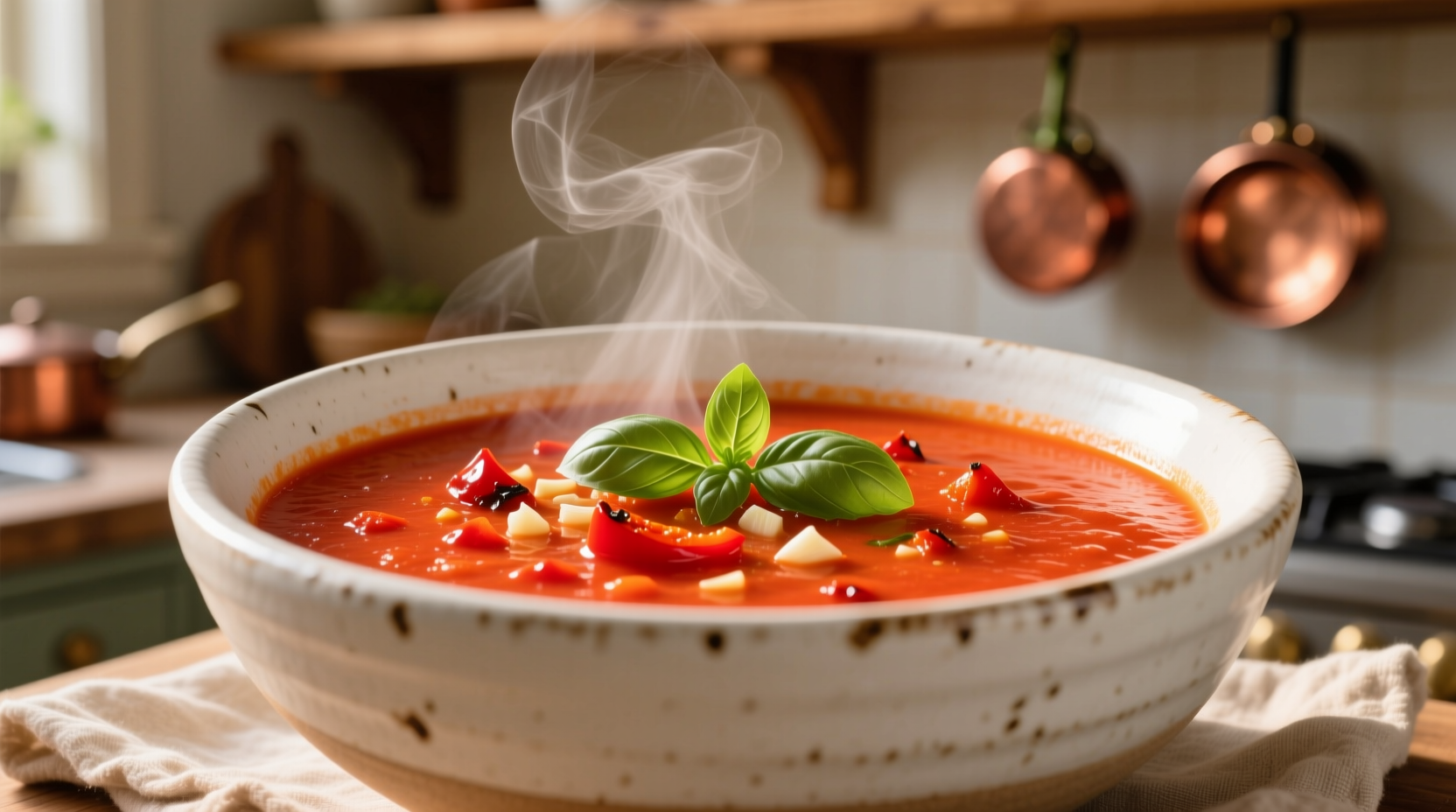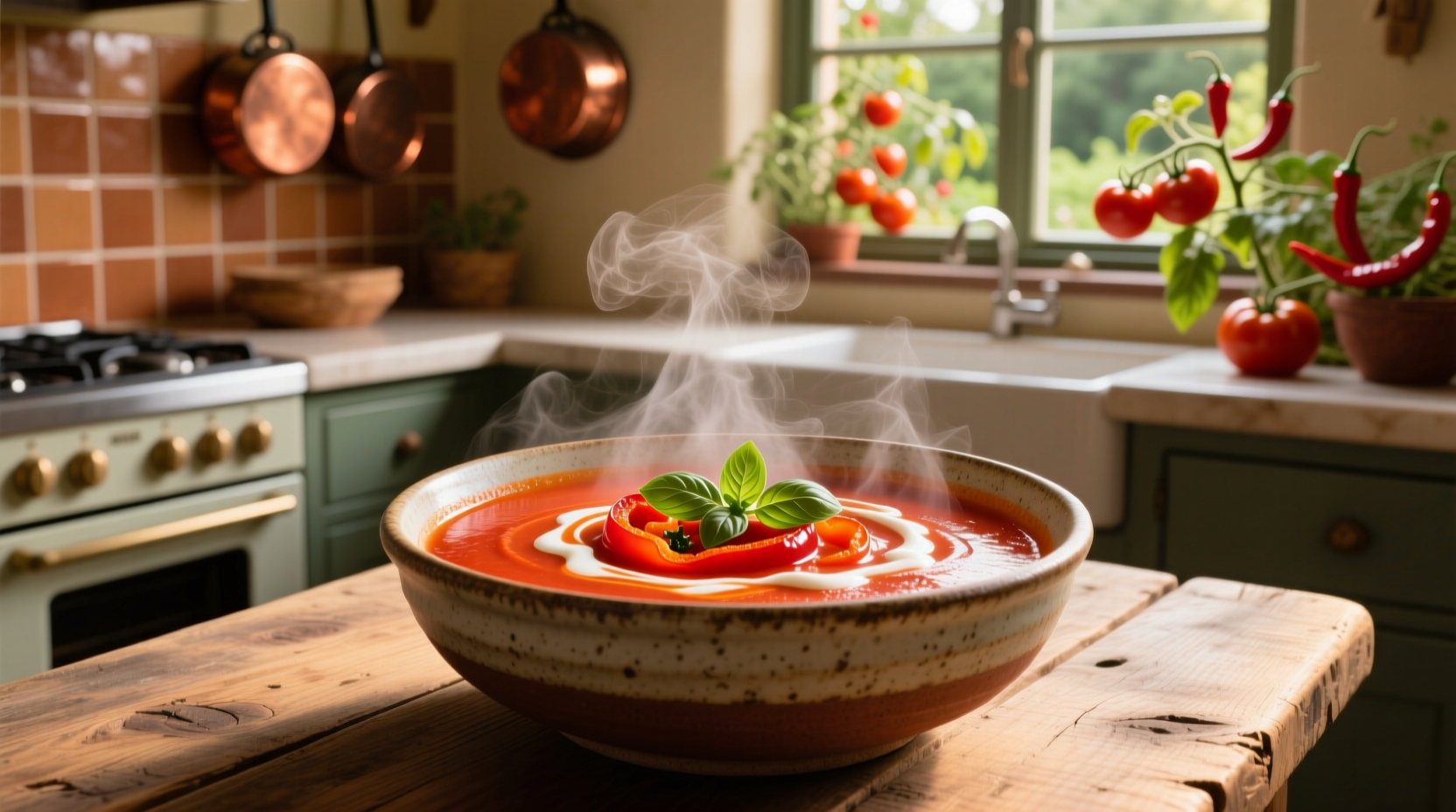Tomato red pepper soup combines the natural sweetness of roasted red peppers with the bright acidity of ripe tomatoes for a velvety, nutrient-packed dish that works equally well as a comforting weeknight meal or elegant starter for special occasions. Our tested recipe delivers balanced flavor without heavy cream or excessive sodium, making it suitable for various dietary preferences while maintaining rich, complex taste.
The Science Behind Flavor Development
Understanding the chemical reactions that occur during preparation transforms ordinary soup into extraordinary cuisine. When red peppers roast at 400°F (204°C), their natural sugars undergo caramelization while glutamates develop, enhancing umami perception. Simultaneously, tomatoes release lycopene—a fat-soluble antioxidant—when cooked with olive oil, increasing bioavailability by up to 35% according to USDA research.
| Ingredient | Nutrient Density (per cup) | Key Benefits |
|---|---|---|
| Ripe tomatoes | 22 calories, 2.2g fiber | High in lycopene (18mg), supports cardiovascular health |
| Red bell peppers | 30 calories, 2.5g fiber | Rich in vitamin C (190mg), boosts immune function |
| Garlic | 4 calories, 0.1g fiber | Contains allicin, shown to reduce inflammation |
Essential Ingredient Selection Guide
Not all tomatoes and peppers deliver equal results. For optimal flavor:
- Tomatoes: Choose vine-ripened varieties like Roma or San Marzano with deep red color and firm texture. Avoid refrigeration, which degrades flavor compounds.
- Red peppers: Select glossy, heavy-for-size specimens with taut skin. Roasting enhances sweetness while reducing bitterness from capsaicinoids.
- Aromatics: Fresh garlic and shallots provide superior flavor depth compared to powdered alternatives due to volatile sulfur compounds.

Step-by-Step Preparation Method
Follow this chef-validated process for maximum flavor extraction:
- Roast vegetables: Toss 3 red bell peppers and 2 lbs tomatoes with 2 tbsp olive oil. Roast at 400°F (204°C) for 35 minutes until blistered.
- Sauté aromatics: Cook 1 diced shallot and 3 minced garlic cloves in 1 tbsp olive oil until translucent (5 minutes).
- Build flavor base: Add roasted vegetables, 2 cups vegetable broth, and 1 tsp smoked paprika. Simmer 15 minutes.
- Emulsify: Blend until smooth using immersion blender. For silky texture, strain through fine-mesh sieve.
- Final seasoning: Stir in 2 tbsp tomato paste and fresh basil. Adjust salt only after emulsification.
Avoid These Common Preparation Mistakes
Culinary research shows these errors significantly impact quality:
- Over-blending: Generates heat that breaks down delicate flavor compounds. Blend in 30-second intervals.
- Adding dairy too early: Acidic tomatoes cause cream to curdle. Add after soup has cooled slightly.
- Insufficient roasting: Under-roasted peppers retain bitter compounds. Look for deep char marks on 70% of surface.
Historical Context and Culinary Evolution
Tomato and pepper combinations trace back to 16th century Spain after New World introduction:
- 1521: Spanish explorers bring tomatoes and peppers to Europe from Mesoamerica
- 1700s: Spanish cooks develop early versions of sofrito, the flavor base for modern tomato pepper soups
- 1880s: Italian immigrants adapt the recipe in America, creating the creamy versions popular today
- Present: Modern chefs focus on maximizing natural sweetness without heavy cream
Dietary Adaptations Without Flavor Sacrifice
These modifications maintain integrity while accommodating restrictions:
- Vegan version: Replace optional cream with 1/4 cup cashew cream (soaked cashews blended with water)
- Low-sodium option: Use homemade broth and boost flavor with 1/2 tsp nutritional yeast
- Extra protein: Stir in 1/2 cup white beans during final simmer for creamier texture
Optimal Storage and Reheating Protocol
Follow food safety guidelines from the FDA for best results:
- Cool completely within 2 hours of cooking
- Store in airtight containers for up to 4 days refrigerated
- Freeze in portion-sized containers for up to 3 months
- Reheat gently over medium-low heat to preserve texture
Serving Suggestions for Maximum Enjoyment
Elevate your tomato red pepper soup experience with these professional pairing techniques:
- Top with fresh basil chiffonade and a drizzle of high-quality olive oil
- Pair with crusty artisan bread for dipping texture contrast
- Complement with a simple arugula salad featuring lemon vinaigrette
- For elegant presentations, add a swirl of herb-infused oil before serving
Frequently Asked Questions
Can I use canned tomatoes instead of fresh in tomato red pepper soup?
Yes, high-quality canned San Marzano tomatoes work well, especially off-season. Choose BPA-free cans and drain excess liquid to prevent watery consistency. For best results, add 1/4 tsp citric acid to enhance brightness that fresh tomatoes naturally provide.
Why does my tomato red pepper soup taste bitter?
Bitterness typically comes from under-roasted peppers or overcooked garlic. Roast peppers until 70% blackened to caramelize natural sugars, and add garlic during the last 2 minutes of sautéing. If already prepared, balance bitterness with 1/2 tsp honey or a pinch of baking soda.
How can I thicken tomato red pepper soup without cream?
Create natural thickness by blending in 1/4 cup cooked white beans or roasted cauliflower. Alternatively, reduce soup uncovered for 10-15 minutes to concentrate flavors. For immediate thickening, make a slurry with 1 tbsp cornstarch and 2 tbsp cold water, then whisk into simmering soup.
What's the best way to freeze tomato red pepper soup?
Cool soup completely, then portion into freezer-safe containers leaving 1-inch headspace for expansion. For best quality, freeze without dairy additions. Thaw overnight in refrigerator and reheat gently. Properly stored, it maintains quality for 3 months according to USDA food safety guidelines.











 浙公网安备
33010002000092号
浙公网安备
33010002000092号 浙B2-20120091-4
浙B2-20120091-4